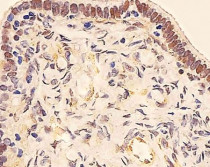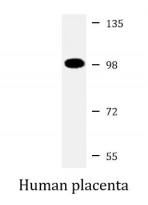ARG40144
anti-OVGP1 antibody
anti-OVGP1 antibody for Flow cytometry,IHC-Formalin-fixed paraffin-embedded sections,Western blot and Human
Overview
| Product Description | Rabbit Polyclonal antibody recognizes OVGP1 |
|---|---|
| Tested Reactivity | Hu |
| Tested Application | FACS, IHC-P, WB |
| Host | Rabbit |
| Clonality | Polyclonal |
| Isotype | IgG |
| Target Name | OVGP1 |
| Antigen Species | Human |
| Immunogen | KLH-conjugated synthetic peptide between aa. 107-137 of Human OVGP1. |
| Conjugation | Un-conjugated |
| Alternate Names | MUC9; Mucin-9; Oviductal glycoprotein; Estrogen-dependent oviduct protein; EGP; OGP; CHIT5; Oviductin; Oviduct-specific glycoprotein |
Application Instructions
| Application Suggestion |
|
||||||||
|---|---|---|---|---|---|---|---|---|---|
| Application Note | IHC-P: Antigen Retrieval: Heat mediation was performed in Citrate buffer (pH 6.0). * The dilutions indicate recommended starting dilutions and the optimal dilutions or concentrations should be determined by the scientist. |
||||||||
| Positive Control | Human placenta |
Properties
| Form | Liquid |
|---|---|
| Purification | Purification with Protein A and immunogen peptide. |
| Buffer | PBS and 0.09% (W/V) Sodium azide. |
| Preservative | 0.09% (W/V) Sodium azide. |
| Storage Instruction | For continuous use, store undiluted antibody at 2-8°C for up to a week. For long-term storage, aliquot and store at -20°C or below. Storage in frost free freezers is not recommended. Avoid repeated freeze/thaw cycles. Suggest spin the vial prior to opening. The antibody solution should be gently mixed before use. |
| Note | For laboratory research only, not for drug, diagnostic or other use. |
Bioinformation
| Database Links | |
|---|---|
| Gene Symbol | OVGP1 |
| Gene Full Name | oviductal glycoprotein 1, 120kDa |
| Background | This gene encodes a large, carbohydrate-rich, epithelial glycoprotein with numerous O-glycosylation sites located within threonine, serine, and proline-rich tandem repeats. The gene is similar to members of the mucin and the glycosyl hydrolase 18 gene families. Regulation of expression may be estrogen-dependent. Gene expression and protein secretion occur during late follicular development through early cleavage-stage embryonic development. The protein is secreted from non-ciliated oviductal epithelial cells and associates with ovulated oocytes, blastomeres, and spermatozoan acrosomal regions. [provided by RefSeq, Jul 2008] |
| Function | Binds to oocyte zona pellucida in vivo. May play a role in the fertilization process and/or early embryonic development. [UniProt] |
| Cellular Localization | Cytoplasmic vesicle, secretory vesicle. Note=Secretory granules. [UniProt] |
| Calculated MW | 75 kDa |
Images (3) Click the Picture to Zoom In
-
ARG40144 anti-OVGP1 antibody IHC-P image
Immunohistochemistry: Paraformaldehyde-fixed and paraffin-embedded Human fallopian tube was blocked with 3% BSA for 0.5 hour at RT. Antigen Retrieval: Heat mediation was performed in Citrate buffer (pH 6.0). Samples were stained with ARG40144 anti-OVGP1 antibody at 1:25 for 1 hour at 37°C.
-
ARG40144 anti-OVGP1 antibody WB image
Western blot: 20 µg of Human placenta lysate stained with ARG40144 anti-OVGP1 antibody at 1:2000 dilution.
-
ARG40144 anti-OVGP1 antibody FACS image
Flow Cytometry: HeLa cells were fixed with 2% paraformaldehyde (10 min) and then permeabilized with 90% methanol for 10 min. The cells were then incubated in 2% BSA to block non-specific protein-protein interactions followed by ARG40144 anti-OVGP1 antibody (right histogram) at 1:25 dilution for 60 min at 37°C, followed by DyLight®488 labelled secondary antibody. Isotype control antibody (left histogram) was Rabbit IgG1 (1 µg/10^6 cells) used under the same conditions. Acquisition of > 10000 events was performed.








